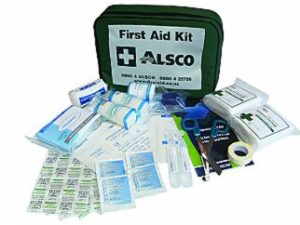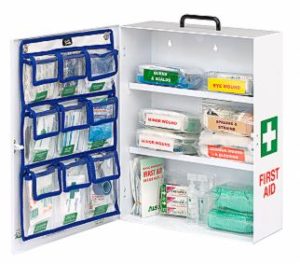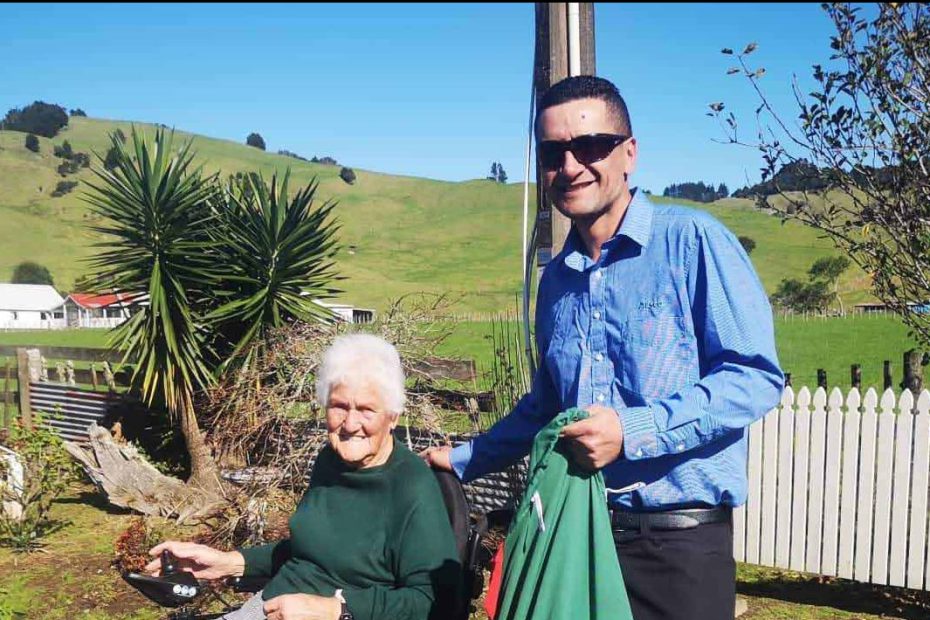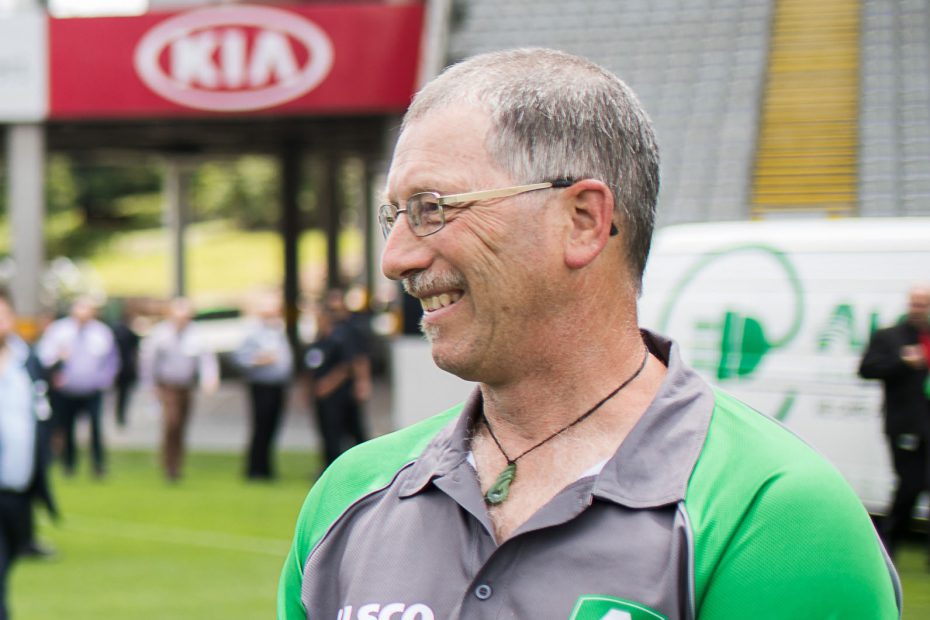It was due to the railway construction in 1888 that first aid kits emerged.
Robert Wood Johnson was on a train en route to Colorado when he wound up speaking to the chief surgeon of the Denver and Rio Grande Railway.
The doctor revealed the dangers of railroad construction. Especially the shortage of medical supplies to treat industry-specific ailments.
Hospitals were a distance away and proved troublesome to reach for emergencies.
This gave Robert his eureka moment, a chance to both advance the field of healthcare and develop his business.
Then came the genesis of Johnson & Johnson’s First Aid Kit!
What First Aid is Required in the Workplace?
First aid refers to immediate help given to any person in distress or pain over a serious illness or injury before a doctor, health professional or emergency service intervene.
The aim is to preserve life and prevent the condition from worsening.
This is done by maintaining breathing and circulation levels, immobilizing broken bones, stemming blood, protecting the unconscious and more.
At work, there are three categories for first aid requirements:
- Well stocked facilities and first aid kits
- Information for employees on first aid dispositions
- Trained first aiders available where needed
Here you will find suggestions to help you organise adequate first aid kits, the number of first aiders needed, facilities and helpful information for employees.
Find out What are the contents of a First Aid Kit?
Did you know that every workplace has a legal obligation to ensure ample first aid provisions?
If you are a person conducting business or undertaking (PCBU), it is your responsibility to ensure your workplace provides employees and others with access to proper first aid equipment.
Several factors come into play when determining the set-up of your first aid equipment and the number of first aiders you may need.
Certain workplaces have heightened risks of injury and illnesses because of the nature of the work undertaken.
These factors could range from the size of your workforce, the industry, location and so on. they aim to help you counter the possible risks and be better prepared.
Employers must then provide first aid kits that take into account all the potential hazards of the workplace or industry.
A sure way to get this done is to conduct a needs assessment that will help you determine your first aid requirements.
Note: this should also include deliberation with your employees to take their views into account.
How to Conduct a First Aid Needs Assessment
You can use these questions as a guideline:
1. What Are the Hazards in my Workplace and Is There Any Potential Harm?
Examples of hazards are:
- Physical: Physical hazards consist of environmental factors that can harm an employee. Including (but not limited to) heights, noise, radiation and pressure.
- Biological: Biological hazards could be bacteria, insects, viruses, animals, etc., that can bring about dire health impacts. Click this link to find 4 Ways to Maintain Your Workplace Hygiene Effectively.
- Chemical: Chemical hazards are substances that can inflict harm. These hazards can have both health and physical impacts, such as skin irritation, blindness, respiratory system irritation etc.
- Ergonomic: Ergonomic hazards come about when physical factors can result in musculoskeletal injuries. For example, a poor workstation set up in an office, poor posture and manual handling.
2. How Many Employees Are in the Workplace and Where Are They Located?
The higher the number of employees, the more the facilities required. An awareness of the number of employees will also help you determine if you need trained first aiders, and how many.`
When it comes to trained first aiders consider:
- Location of the establishment and the distance from medical services.
- The likelihood of people being hurt and the intensity of the injuries.
- The size of the workplace and how dispersed your employees are within the location.
- The number of employees in the workplace at all times.
- The nature of their work and the hazards they face.
- Whether there are other people than employees at the workplace i.e. clients.
You need to allow some of your first aiders to have their leave days, or to be absent on unplanned occasions such as sick leave.
This means your first aid provisions must be able to cover all hours when employees are working. This includes their shifts and overtimes.
Regardless of their work plan or schedules, employees need access to first aid.
Workplaces that have employees with disabilities or special needs need to also have their medical and first aid needs taken into account.
To do so, consultation should occur with the employees concerned (with their consent) for their best medical advice.
3. If Employees of More Than One Employer Are Working Together Can They Share First Aid Resources?
It could be easy to get equipment mixed up if there are multiple first-aid boxes present. In such environments, it would be advisable to agree to share first-aid provisions. An agreement could be made, for example, the employer with a higher number of employees on-site can handle the first aid provisions.
To avoid conflict, the agreement should be in writing and both parties owning copies. Each employer has to make sure the employees are also aware of the agreement.
4. How Does the Size and Layout of My Workplace Affect My First Aid Needs?
This depends on accessibility.
First aid kits should be easy to access especially in case of an emergency. To do so, you must consider:
- The size of your workplace.
- The time it takes to access the first aid kit.
- If employees are spread out in several buildings across a worksite.
- If employees work on several floors or one floor of a building.
- The communication channels in large worksites and how fast they are i.e telephones, pagers.
- The security on site and after-hour requirements.
5. What about Employees Who Work Away from the Site?
When employees are working away from the main workplace you should ensure they have portable first aid provisions with them. It varies according to the work being conducted, the potential risks and if they are working in groups or alone.
Alsco offers light, compact and portable vehicle first aid kits that would be great to have in such situations. They are colour coded thus easy to use and have the most essential supplies meaning your employees as safe as possible wherever they are.
6. How Does the Location of My Workplace Affect First Aid Needs?
Your employees may require immediate medical attention that surpasses the abilities of a first aid kit. If hospitals, medical centres or ambulances are far away this could pose a challenge.
Workplaces in remote locations need to have back-up plans or special arrangements. Find a medical service you can partner with and understand how they operate; their working hours, their efficiency and so on.
7. Can You Provide First Aid for People Who Aren’t Employees?
Yes, anyone who requires first aid in your workplace should be able to receive it.
This could include contractors, volunteers, interns or work experience trainees and loaned employees.
As such your first aid provisions should take others into account. Your kit needs to be as extensive as possible.
You can get Alsco to provide your workplace with managed first aid kit services that are regularly restocked and tailored to suit your business at a single, all-inclusive annual fee.
8. What If My Workplace Provides In-House Occupational Health Services?
This is a bonus to your workplace and first aid planning can be done in consultation with the medical practitioners in charge.
It does not need to be staffed continuously, as long as there is sufficient help or coverage for employees when the service is not operating. This is when the trained first aiders can step in.
Trained First Aiders Needed?
This is dependent on the hazards in your workplace, the number of your employees, their workstations and how your location in terms of access to medical services.
The needs assessment test should help you be able to gauge the needs of your workplace better and judge how many trained first aiders you should have.
You need to think about ensuring that first aid cover is available on all shifts and determine if the first aid response is adequate for the hazards employees face.
Alsco’s managed rental service has other types of first aid kits and services to handle various emergencies. Remember, having a well-stocked first aid kit can make all the difference in an emergency.




